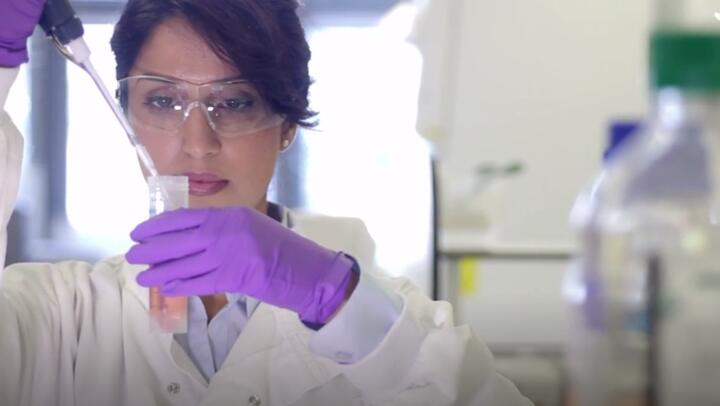
Unfortunately, a lot of people today have experienced the fight against cancer ourselves or watched a loved one battle it—we’re all too familiar with the most common types. But there are many cancers that are far more rare than breast or lung cancer. One of those more rare cancers is called polycythemia vera (PV). PV falls under a group of blood cancers called myeloproliferative neoplasms (MPN).
In patients with PV, the bone marrow produces too many red blood cells. Sometimes, PV can also cause your body to make too many of the other types of blood cells: white blood cells and platelets. When you have too many blood cells, this thickens your blood, which can cause complications like bleeding or blood clots. This is a serious problem, since blood clots that occur in your head can cause a stroke, and blood clots occurring in your arteries can cause a heart attack.
And in some cases, these extra blood cells can group together in the spleen and cause it to enlarge. PV can be life threatening if it goes untreated, but there’s good news: with the right medical care, many people live normal lives with few, if any, problems related to the condition.
PV occurs more commonly in men than women, and it rarely affects people younger than 60 years old. Experts believe that PV may be caused by a genetic mutation. Usually, your body regulates the number of blood cells you have, but 95% of patients with PV have a defect in a regulatory gene called JAK2 that interrupts the body’s careful balance. This defect leads to unchecked blood cell proliferation, yielding abnormalities in blood cell number and their functional quality. Researchers don’t know what causes this genetic mutation, but they don’t believe it’s hereditary.
It’s also possible that exposure to intense amounts of radiation and possibly toxic substances may increase the risk of PV, but this theory is new and requires more data to back it up.
In many cases, polycythemia vera doesn’t cause any signs or symptoms, but some people may experience:
Sweating, especially at night
Ringing in the ears
Reddish or purplish skin
Bleeding on clothing
Unexpected weight loss
Feeling very full or bloated (caused by an enlargement of your spleen)
Itching, especially after a shower
Burning, red hands and feet
Painful swelling of one joint, especially the big toe
Difficulty breathing when lying down
Some people experience all these symptoms, just several, or none at all.
Since PV doesn’t always show clear symptoms, many patients are diagnosed after a routine blood test reveals an increase in their red blood cells, sometimes along with an increase in white blood cells or platelets. But patients may also get diagnosed after seeing their doctors about their symptoms. There are several diagnostic tests that doctors use to see if someone may have PV, including:
Blood tests: a complete blood count (CBC) can show an increase in the blood cell levels in your body.
Bone marrow aspiration or biopsy: this procedure can examine if there’s a problem with how the bone marrow is producing blood cells.
Test for genetic mutations: since almost all PV patients have a JAK2 gene mutation, doctors may test to see if the mutation is present.
Low erythropoietin level testing: erythropoietin is a hormone involved in the production of red blood cells. If there are low levels of this hormone, that may be a sign of PV.
Unfortunately, PV cannot be cured at this time; most of the treatment options share the goal of rebalancing the number of blood cells in your body. But treatment can prevent complications from occurring and reduce or eliminate symptoms—most people with PV live long lives if their condition is well controlled. Every patient is different, so while some patients without symptoms may not need treatment all the time, others will. And in all cases, PV patients should see their doctors routinely to monitor blood cell levels and symptoms.
There are several common and effective treatment options for PV:
Phlebotomy
This procedure, which decreases total blood volume, is typically the first treatment option for PV. Specialists will draw one unit of blood from your veins every week until the number of red blood cells drops.
Low-Dose Aspirin
For mild PV, your doctor may want you to take a low dose of aspirin daily to reduce your risk of blood clots. Aspirin can also help ease PV symptoms of burning pain in your feet and hands.
Hydroxyurea (Droxia, Hydrea)
If a phlebotomy and aspirin isn’t enough, your doctor may suggest medication like hydroxyurea—this prevents your bone marrow from producing so many blood cells. It’s more likely that this drug will be used if your other blood cell counts are also high, or if you are at high risk of blood clots.
Pegylated Interferon
If further treatment is needed, you may take interferon, which stimulates your immune system to keep red blood cell production down. This option is often used in women who are younger, who may become pregnant, because it has not been shown to cause birth defects. Interferon was developed to treat hepatitis C, so its use for PV is considered off-label, which means this use is different than the manufacturer intended. However, clinical trials are currently evaluating the treatment specifically for PV.
Ruxolitinib (Jakafi)
If other treatments aren’t effective, you’ve got a new option: ruxolitinib. This medication is the first treatment approved by the U.S. Food and Drug Agency (FDA) for PV patients. It blocks overproduction of red blood cells and also helps reduce the risk of developing an enlarged spleen.
Along with medical therapies, it’s important for patients with PV to follow a healthy diet and exercise plan.
Although treatment for PV is typically effective, there are several possible complications of having the condition. Patients have an increased risk for blood clots and enlarged spleen, as well as skin problems (specifically related to itching or burning). Patients also sometimes experience problems caused by their high level of red blood cells, like peptic ulcers (sores on your stomach lining) and gout (joint inflammation). In very rare cases, PV can progress to more serious blood diseases, such as myelofibrosis, a bone marrow disorder, or myelodysplastic syndrome, a stem cell disorder. Very few PV patients go on to develop acute leukemia, which is cancer of the blood and bone marrow.
With the right treatment, patients with PV can typically live full lives unburdened by this disorder. If you or a loved one experience the signs and symptoms of PV, it’s important to see a doctor as soon as possible.



















